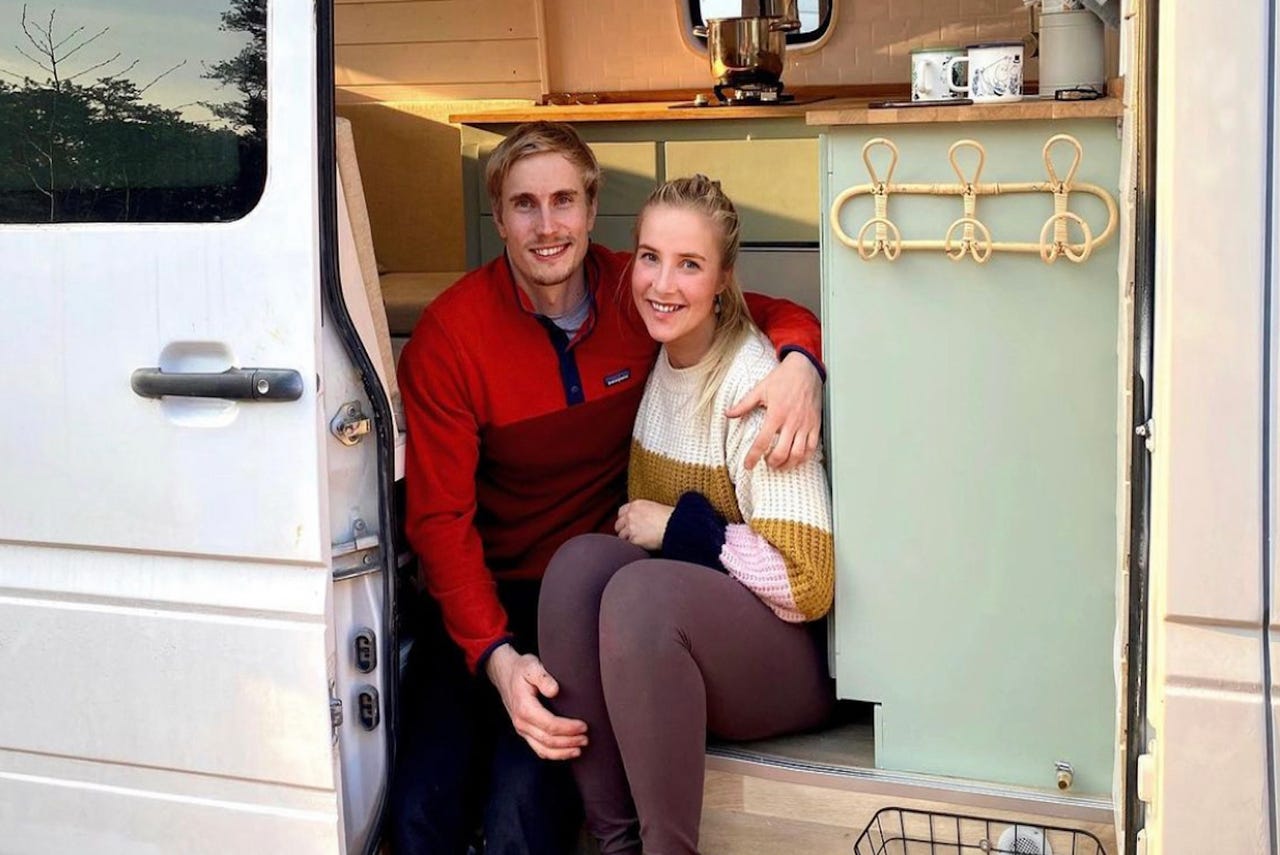The ultimate in remote working? My life on the road as a digital nomad


When Laura Tiensuu's employer switched to fully remote working, instead of creating a home-office space, she saw a chance to do something she has always wanted: become a digital nomad, working, traveling and living in a van.
Special Feature
Since last year, Tiensuu and her partner have traveled across Europe in their customized van, working their different jobs during the day and climbing and exploring places like the French Alps and canyons in Northern Spain during their spare time.
"Being fully remote allowed us this opportunity to combine our personal and professional passions," says Tienssu, a marketing data and analytics manager at tech company Aiven. "I just find it so much easier disconnecting from work."
SEE: Remote-working jobs vs back to the office: Why tech's Great Resignation may have only just begun
Tiensuu's workday is mostly spent inside the van, but she takes breaks throughout the day to walk or explore the new and beautiful landscape she is parked in for the time being. While work is a priority, she tries to take advantage of good weather when it happens and shuffles her working hours around to allow for more time for her favorite pastime: climbing.
"I try to spend as many of the good weather windows outside as possible and try to work when it's raining – regardless of what day of the week it is," she said. "When the weather is good and I'm working, I often work with the van door wide open or even from outside the van."
The digital nomad lifestyle, or someone who works remotely while traveling to different places, has increased among younger workers since the start of the pandemic. In 2021, there were 35 million digital nomads worldwide, Tiensuu and her partner among them.
Becoming a full-time digital nomad took almost a year of preparations – working on the van in the evenings and weekends to make it the space they could both live and work in. This included installing an external antenna in the roof of the van, as well as a Wi-Fi box inside the van so the two can have internet access no matter if they are in a city or parked in a national park off the grid.
"We also purchase a local SIM card in every country we are visiting, which allows us to have a pretty good connection," she said.
The van life lifestyle doesn't come without its challenges, though. Tiensuu said they have broken down on the side of the road before and have run out of solar power mid-Zoom meeting.
The two have also had to navigate working and sharing such a small space. Tiensuu said when building out the van, they made sure to have enough desktop space built-in for both as well as investing in the right tools like noise-canceling headphones and microphones so they can have calls simultaneously. "Lots of scheduling goes into it," Tiensuu said. "The proper workspace is super-important, so we built out that first and then everything else around it."
Tiensuu and her partner are still traveling Europe, most recently in Spain. She said she wouldn't trade this lifestyle for anything.
"This has only positively impacted my motivation and my commitment to my work," she said. "I would love to see as many people as possible experience this."
ZDNET Recommends
Remote work used to be an anomaly – if you had a work-from-home policy at your job, you were one of the lucky ones. But once the pandemic forced many office workers to remote work in some capacity, it quickly became the norm for companies like Tiensuu's to go remote.
According to the 2021 State of Remote Work Report from Owl Labs, 90% of the full-time remote workers surveyed said they were more productive working remotely than in an office. In addition, 74% said working from home was better for their mental health, and 84% reported that a permanent work-from-home option would make them happier, even if that meant taking some kind of pay cut.
While research suggests that 21% of digital nomads are like Tiensuu and work in a van/camper, 27% opt to work in Airbnbs. Kelly Farrell, a lead technical product manager at Vista/Cimpress, was one such digital nomad that wanted to take advantage of remote work-life by traveling while still having some simple luxuries.
"We stayed at Airbnbs in different places around the country that we wanted to check out," she said. "We got to get outside more, were healthier and happier, ate lots of different food, and got more steps in."
Farrell and her then-fiance, now husband, stopped at 17 different spots around the country, spanning five months, all the while working weekdays and exploring every chance they got after work hours and on the weekends. In two weeks alone, they were able to explore Glacier National Park, Yellowstone, and Badlands when they weren't working in their Airbnb.
"I'll never forget driving through Montana and pulling over to look at dinosaur bones at a museum near a well-known dinosaur migration path between Glacier and Yellowstone National Park," she said. "Sometimes it felt surreal to wake up on a Monday morning and call into a daily [meeting] and pretend like I didn't just drive through amazing terrain and see places I never really knew existed."
Like Tiensuu, the logistics of Farrell's trip also took preparations -- from booking places to stay to figuring out how to get to a destination and properly incorporate working when your office space frequently changes. For example, Farrell said they would jerry-rig bedrooms or kitchens to function as offices and bring items like standing desk converters, Bluetooth keyboards and mice, and noise-canceling headphones to make those spaces into offices.
And, since the two were never in one timezone for very long, they always worked on East Coast time, which provided them with extra after-work hours of sunshine and exploring if they were on the West Coast.
"After a day of work, we would go out and explore where we were. In Austin, we would go out to see music or get tacos; in Tucson, we would go play tennis or go for a hike," Farrell said.
According to Nomad List, an online resource for digital nomads, some of the best places for digital nomads in the US include Austin and Tucson, along with Miami and Denver. Across the globe, some of the top-rated places to work remotely as a digital nomad are the Canary Islands in Spain, Lisbon, and Cape Town.
Whether it's road tripping the US or Europe, the digital nomad lifestyle allows remote workers to explore these places and more instead of working day in and day out in the average home office.
"With remote-first, you could do anything you want to do. You can become a snowbird when you're 25," Farrell said. "I think most people have to wait until they are retired to go on a road trip like the one I had the privilege to take while working at Vista/Cimpress."
SEE: Software development is changing again. These are the skills companies are looking for
Despite the unconventional aspects of the digital nomad life, those who have experienced it first-hand say it's changed how they compartmentalize their work and personal lives, blending the two to make both an experience.
"I've seen some pretty big benefits, especially in terms of appreciation towards my employer," Tiensuu said. "I find this kind of flexibility much better than any of the more traditional benefits that you see."
Farrell agrees with Tiensuu and says that flexibility at work has become too important for many remote workers to give up.
"I think that employees having more flexibility is probably the future of work, being able to live the way you want to live," she said. "I think you want different things from work at different times in your life, so having that flexibility is super important."